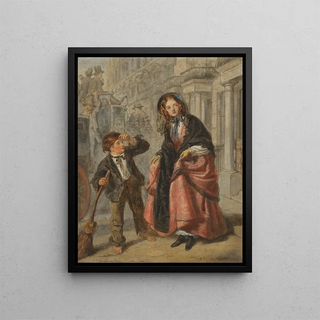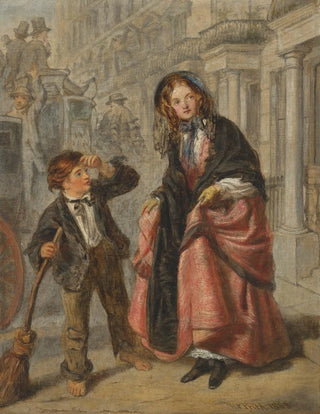Art print | The crossing sweeper (Conflict of case) - William Powell Frith


View from behind

Frame (optional)
In the vibrant world of Victorian art, William Powell Frith's "The Crossing Sweeper (Case Conflict)" stands out for its striking realism and ability to capture the very essence of everyday life. This painting, created in 1862, depicts a scene from urban life where the tension between industrial progress and human concerns is palpable. Frith, a true observer of his time, invites us to delve into a rich visual narrative, where each character seems to tell a unique story. The art print of this iconic work allows us to rediscover a key moment in social and artistic history, while offering a window into 19th-century England.
Style and uniqueness of the work
Frith's style is a perfect example of realism, characterized by meticulous attention to detail and faithful representation of human emotions. In "The Crossing Sweeper (Case Conflict)", the composition is dynamic, almost theatrical, with characters arranged to create palpable tension. The sweeper, the central figure of the painting, embodies the daily struggles of workers facing the challenges of industrialization. Vibrant colors and play of light enhance the scene's intensity, while the expressions of the characters reveal emotions ranging from worry to resignation. Frith's ability to capture fleeting moments of human life, anchoring them in a historical context, gives this work a timeless dimension.
The artist and his influence
William Powell Frith, born in 1819, is often regarded as one of the greatest artists of his era. His career spanned several decades, during which he evolved while remaining true to his realist roots. Frith was influenced by the Pre-Raphaelite movement, but he developed a style that was uniquely his own, blending a keen sense of observation with a narrative approach. His work not only marked his time but continues to inspire many contemporary artists. By highlighting the social realities of his era, Frith paved the way for a new

Matte finish

View from behind

Frame (optional)
In the vibrant world of Victorian art, William Powell Frith's "The Crossing Sweeper (Case Conflict)" stands out for its striking realism and ability to capture the very essence of everyday life. This painting, created in 1862, depicts a scene from urban life where the tension between industrial progress and human concerns is palpable. Frith, a true observer of his time, invites us to delve into a rich visual narrative, where each character seems to tell a unique story. The art print of this iconic work allows us to rediscover a key moment in social and artistic history, while offering a window into 19th-century England.
Style and uniqueness of the work
Frith's style is a perfect example of realism, characterized by meticulous attention to detail and faithful representation of human emotions. In "The Crossing Sweeper (Case Conflict)", the composition is dynamic, almost theatrical, with characters arranged to create palpable tension. The sweeper, the central figure of the painting, embodies the daily struggles of workers facing the challenges of industrialization. Vibrant colors and play of light enhance the scene's intensity, while the expressions of the characters reveal emotions ranging from worry to resignation. Frith's ability to capture fleeting moments of human life, anchoring them in a historical context, gives this work a timeless dimension.
The artist and his influence
William Powell Frith, born in 1819, is often regarded as one of the greatest artists of his era. His career spanned several decades, during which he evolved while remaining true to his realist roots. Frith was influenced by the Pre-Raphaelite movement, but he developed a style that was uniquely his own, blending a keen sense of observation with a narrative approach. His work not only marked his time but continues to inspire many contemporary artists. By highlighting the social realities of his era, Frith paved the way for a new






